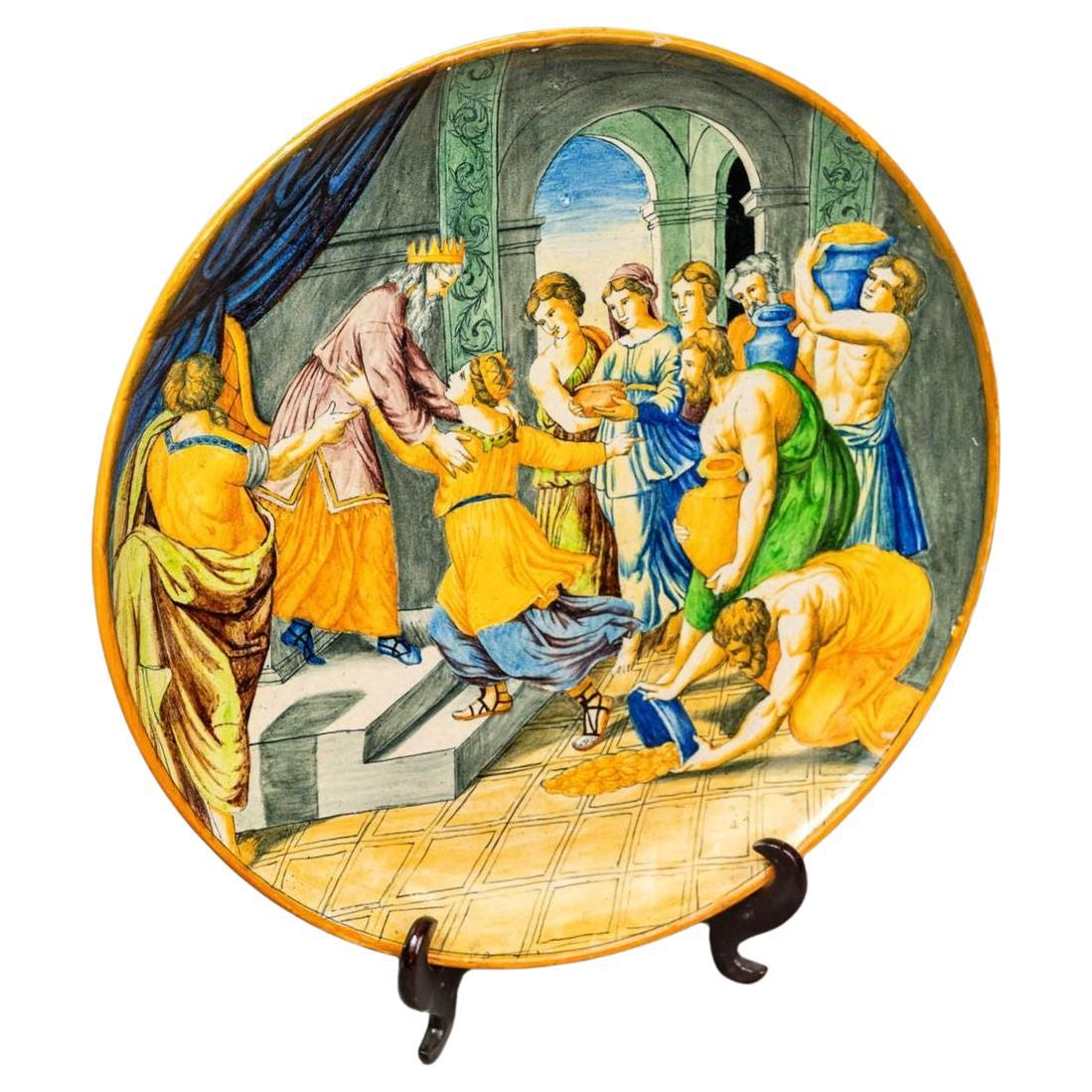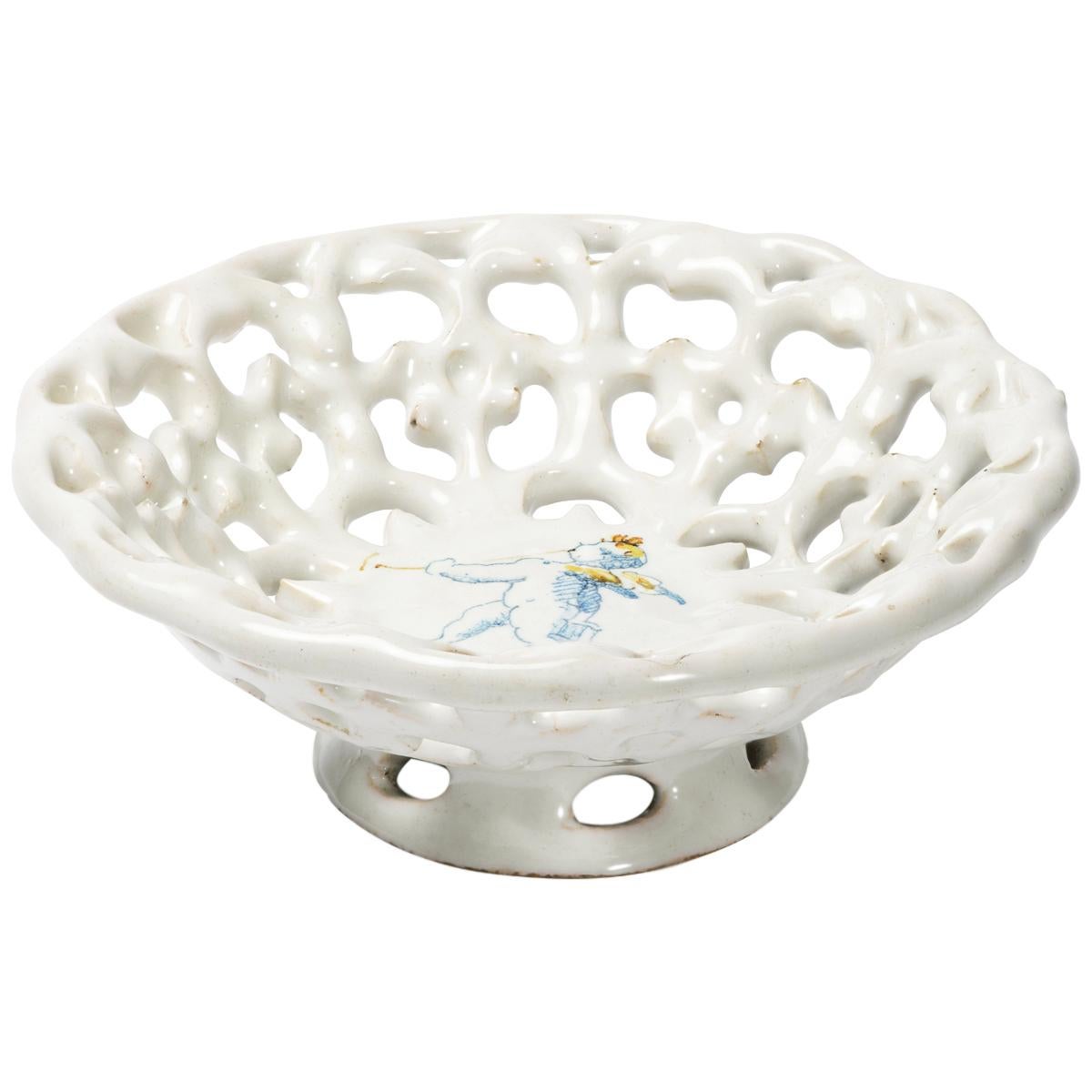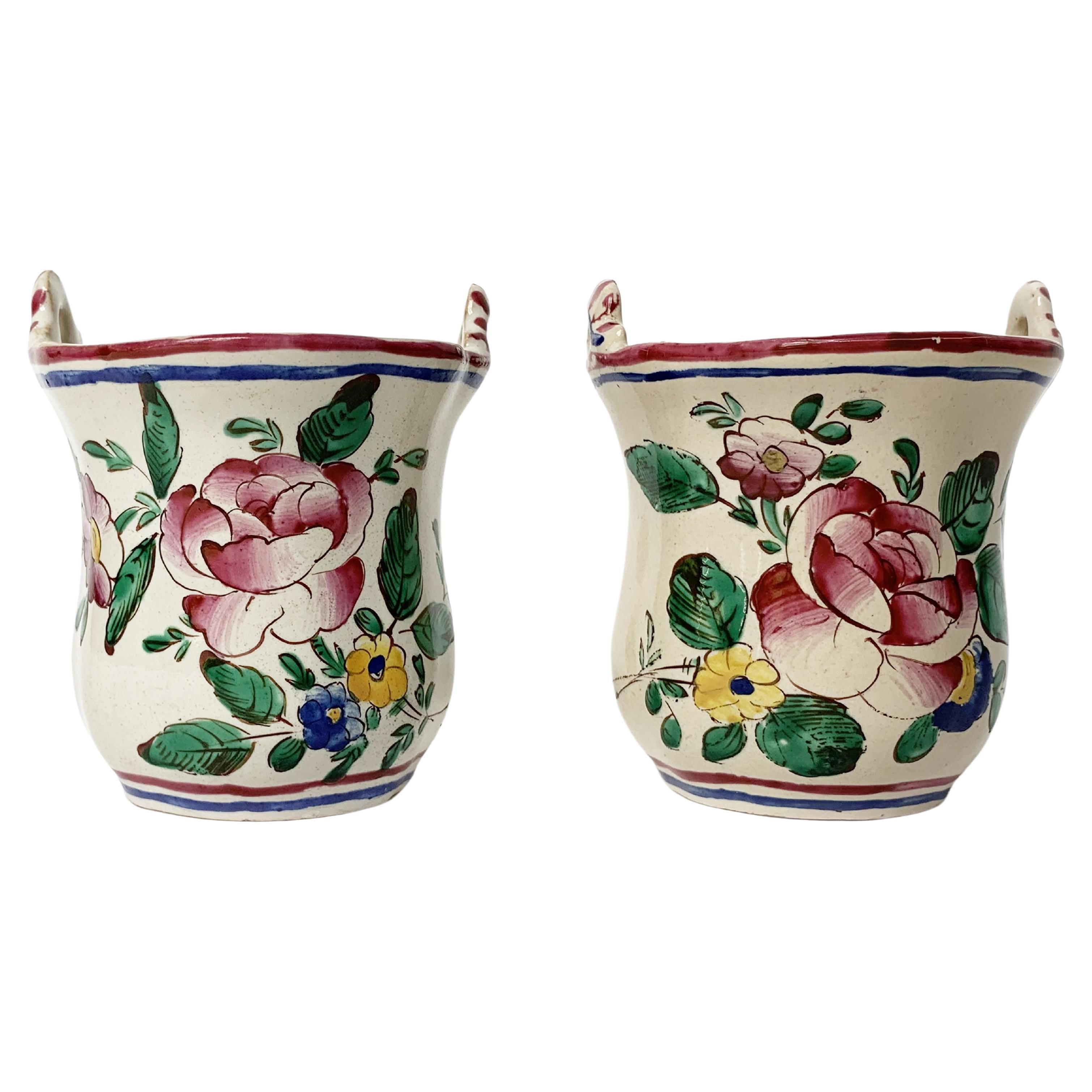Items Similar to Small Maiolica Plate, Urbino District, 1533-1555
Video Loading
Want more images or videos?
Request additional images or videos from the seller
1 of 18
Small Maiolica Plate, Urbino District, 1533-1555
About the Item
Maiolica plate (tondino)
Urbino district, Casteldurante or Pesaro, 1533-1555
It measures: diam. 7.48 in (19 cm), foot diam. 2.75 in (7 cm), height 1.02 in (2,6 cm)
It weighs: 0.67 lb (307 g)
State of conservation: chipping on edge from use and a slight fêlure.
The small plate or “tondino” has a deep well, an oblique border, rounded edge and barely raised ring foot.
The decoration shows, around the edge, a garland of small lanceolate leaves outlined in brown, while the border is richly decorated with the “bianco sopra bianco” (white-on-white) technique. This provides a dense decoration with foliated spirals, outlined in tin white directly on the glaze. Inside the well, in a hilly landscape with the sunset sky, there is a shield framed with the bipartite noble emblem of the Mazza family of Pesaro, surmounted by the letter "M" and flanked by the initials "G" and "P".
The technique used here in the decoration of the border is widely described by Cipriano Piccolpasso in his text, from around 1557, “Li tre libri dell’arte del vasaio” and referring specifically to an Urbino tradition: in the chapter of the “Sopra bianchi “(“White Above”) the author says “questo è uso urbinate” ("this is Urbino custom").
Works with this ornament datable to between 1530 and 1555 were actually found in the Urbino district: numerous fragments from the Ducal Palace of Urbania (Castel Durante), while recent finds in Pesaro, along with those in the Ducal Palace of Urbino itself, explain the difficulty in attributing the work more precisely to one workshop in particular.
Piccolpasso himself underlines slight differences between the works of Casteldurante and those of Urbino. More recent studies tend to propose a Pesaro origin for this service, however, as it was produced for an important family of the coastal city. There is a record of the transfer, around 1534, to Pesaro of Giovanni and his brother Bartolommeo, sons of Antonio Mazza, a spice merchant from Rimini. Then we remember a Gasparre Mazza representative of a second generation of the family. It is therefore likely that the service was produced for the house of Giovanni or Gasparre ("G") Mazza ("M") for the marriage to a hypothetical "P", whose identity, for the moment, remains unknown.
Other small plates of the service, of different sizes, are preserved in public and private collections: see for example the sample, without initials, in the Victoria and Albert Museum (C 2262-1910) and the one, still without initials, at the MET in New York. Another one is attested in the Dreyfuss collection in 1967, while an identical plate has recently been published and is kept in a private collection in Genoa.
Some other unpublished plates from the service are known to be in a private collection, testifying to the importance of the Mazza family's “credenza”.
Bibliography:
Wilson T., The Golden Age of Italian Maiolica Painting, Torino, 2019, pp. 366-368 n. 163 e bibliografia relativa.
Piccolpasso C., I tre libri dell’arte del vasaio, a cura di Giovanni Cecchini, Roma 1963;
Gresta, Riccardo, Un piatto con lo stemma Mazza e qualche nota sui soprabianchi, Faenza: bollettino del Museo internazionale delle ceramiche in Faenza: CIII, 1, 2017 p. 46-55;
Gresta R., Bonali P., La maiolica pesarese nella seconda metà del Cinquecento, in “Pesaro nell’età dei Della Rovere, vol. III.2 di Historica Pisaurensia”, Collana di studi diretta da Scevola Mariotti, Venezia. pp. 354-355
Ravanelli Guidotti C., Thesaurus di opere della tradizione di Faenza, Faenza 1998, p. 254.
- Dimensions:Height: 1.03 in (2.6 cm)Diameter: 7.49 in (19 cm)
- Style:Renaissance (Of the Period)
- Materials and Techniques:Maiolica,Glazed
- Place of Origin:
- Period:
- Date of Manufacture:1533-1555
- Condition:Minor fading. Chipping on edge from use and a slight fêlure.
- Seller Location:Milano, IT
- Reference Number:1stDibs: LU4352228952192
About the Seller
4.3
Vetted Seller
These experienced sellers undergo a comprehensive evaluation by our team of in-house experts.
Established in 1860
1stDibs seller since 2018
19 sales on 1stDibs
Typical response time: 4 hours
Associations
International Confederation of Art and Antique Dealers' Associations
- ShippingRetrieving quote...Ships From: Milano, Italy
- Return PolicyA return for this item may be initiated within 14 days of delivery.
More From This SellerView All
- Italian Renaissance Plate, Patanazzi Workshop Urbino, End of 16th CenturyBy Patanazzi WorkshopLocated in Milano, ITAcquareccia plate Patanazzi workshop Urbino, last quarter of the 16th century It measures diameter 17.12 in; foot diameter 11.53 in; height 1.88 in (43.5 cm; 29.3 cm; 4.8 cm). Weight State of conservation: wear and a few small minimal detachments of enamel, chipping on the raised areas, peeling of enamel at the brim on the back. This large, shallow basin is equipped with a wide and convex well. It is umbonate with a contoured center. The brim, short and flat, is enclosed in a double rounded and barely raised edge. The basin has a flat base without rims; it has a slightly concave center in correspondence to the well. The shape takes inspiration from the basins associated with the metal forged amphora pourers that traditionally adorned the credenza. These were used from the Middle Ages to wash hands during banquets. Two or three people washed their hands in the same basin and it was considered an honor to wash one’s hands with an illustrious person. The decoration is arranged in concentric bands with, in the center of the umbo, an unidentified shield on a blue background: an oval banded in gold with a blue head, a gold star and a field with a burning pitcher. Rings of faux pods separate the center from a series of grotesque motifs of small birds and masks. These go around the basin and are, in fact, faithfully repeated on the brim. The main decoration develops inside the flounce of the basin, which sees alternating symmetrical figures of winged harpies and chimeras. The ornamentation, outlined in orange, green and blue, stands out against the white enamel background. This decorative style, defined since the Renaissance as “grottesche” or “raffaellesche”, refers to the decorations introduced after the discovery of the paintings of the Domus Aurea towards the end of the fifteenth century. The discovery of Nero's palace, buried inside Colle Oppio by damnatio memoriae, occurred by chance when a young Roman, in 1480, fell into a large crack which had opened in the ground on the hill, thus finding himself in a cave with walls covered with painted figures. The great artists present in the papal city, including Pinturicchio, Ghirlandaio, Raffaello, immediately visited these caves. The decorations found there soon became a decorative subject of immense success: the term grotesque , with the meaning of “unusual,” “caricatured,” or “monstrous,” was later commented by Vasari in 1550 as “una spezie di pittura licenziose e ridicole molto”( “a very licentious and ridiculous kind of painting”). The decorations “a grottesche” also widely circulated in ceramic factories, through the use of engravings, variously interpreted according to the creativity of the artists or the requests of the client. Our basin is reflected in similar artifacts produced at the end of the sixteenth century by the factories of the Urbino district. See the series of basins preserved in the main French museums, among which the closest in morphology is that of the Campana collection of the Louvre (Inv. OA1496); this however has a more complex figure decoration, while the decoration of our specimen is sober and with a watercolor style. The style, sure in its execution, approaches decorative results still close to the works produced around the middle of the sixteenth century by the Fontana workshop. The decoration is closely linked to their taste, which later finds its natural outlet, through the work of Antonio, also in the Patanazzi workshop. Studies show the contiguity between the two workshops due to the kinship and collaboration between the masters Orazio Fontana and Antonio Patanazzi, both trained in the workshop of Guido Fontana il Durantino. It is therefore almost natural that their works, often created according to similar typologies and under the aegis of the same commissions, are not always easily distinguishable, so much so that the presence of historiated or “grottesche” works by Orazio is documented and preserved in Antonio Patanazzi's workshop. Given that the studies have always emphasized the collaboration between several hands in the context of the shops, it is known that the most ancient “grottesche” works thus far known, can be dated from 1560, when the Fontana shop created the so-called Servizio Spagnolo (Spanish Service) and how, from that moment on, this ornamentation became one of the most requested by high-ranking clients. We remember the works created for the Granduchi di Toscana, when Flaminio Fontana along with his uncle Orazio supplied ceramics to Florence, and, later, other commissions of considerable importance: those for the service of the Duchi d’Este or for the Messina Farmacia of Roccavaldina, associated with the Patanazzi workshop when, now after 1580, Antonio Patanazzi began to sign his own work. Thus, in our basin, the presence of masks hanging from garlands, a theme of more ancient memory, is associated in the work with more advanced stylistic motifs, such as the hatching of the chimeras and harpies. These are found here on the front with the wings painted in two ornate ways. In addition, the theme of the birds on the edge completes the decoration along the thin brim and can be seen as representing an early style typical of the Urbino district during a period of activity and collaboration between the two workshops. Later, a more “doll-like” decorative choice, typical of the end of the century and the beginning of the seventeenth century, characterized the period of the Patanazzi workshop under the direction of Francesco. Bibliography: Philippe Morel, Il funzionamento simbolico e la critica delle grottesche nella seconda metà del Cinquecento, in: Marcello Fagiolo, (a cura di), Roma e...Category
Antique 16th Century Italian Renaissance Ceramics
MaterialsMaiolica
- Ancient Italian Renaissance Maiolica Crespina, Faenza, 1580 CircaLocated in Milano, ITCrespina Faenza, last quarter of the 16th century Maiolica painted in two colors, light blue and yellow, on a thick, rich layer of white enamel. It measures 2.24 in (5.7 cm) in height, 6.10 in (15.5 cm) in diameter. lb 0.55 (kg 0.25) State of conservation: mimetic restoration. The small cup has a raised central “umbone”, a perforated brim and a shaped rim. It rests on a high jutting foot. The "crespina" shape, in some inventories is cited as "tacce de frute" (fruit cups). It was particularly appreciated in the Renaissance and has variants based on the formal types and the different sizes. The decoration, made according to the dictates of the “compendiario” style, used few standardized colors: blue and yellow on a thick white and shiny enamel, deliberately chosen as the colour which was most reminiscent of silver. This choice derived from a trend in creative design of the era: the shapes used in the molds were often taken from metal objects. An idea which would last throughout the Renaissance. The work shows, in the middle of the “umbone”, a winged putto stepping forward while playing a long thin trumpet. The depiction of the putto is fully representative of the repertoire of the Faenza workshops of the sixteenth century. Some specimens with this type of decoration have been published in a volume by Carmen Ravanelli Guidotti: there appears the whole productive repertoire of this fundamental moment of transition between the taste for the “istoriato” style and the great simplification of decoration in the “compendiario” period. This style, in its simplicity, however, saw its expression in a rather varied collection of decorative subjects, including old-fashioned busts...Category
Antique 16th Century Italian Renaissance Ceramics
MaterialsMaiolica
- Ancient Maiolica Plates Pasquale Rubati, Milan Circa 1770-1780By Pasquale RubatiLocated in Milano, ITFive oval maiolica dishes with pierced edge Manufacture of Pasquale Rubati Milan, 1770-1780 Three small oval dishes 10.23 in x 7.67 in (26 cm x 19.5 cm) Two large oval dishes 10.82 in x 8.85 in (27.5 x 22.5 cm) lb 3.5 (kg 1.8) State of conservation: intact The five dishes of different sizes have an oval shape, a mixtilinear edge and a molded polylobed shape with a surface enriched with a relief weave motif extending to the brim and forming a perforated basket...Category
Antique 1770s Italian Rococo Ceramics
MaterialsMaiolica
- Small Maiolica Flower Pots, Ferretti Manufacture, Lodi, circa 1770-1780By Antonio FerrettiLocated in Milano, ITTwo maiolica flower pots Antonio Ferretti Manufacture Lodi, Circa 1770 - 1780 Maiolica polychrome decorated “a piccolo fuoco” (third fire) The...Category
Antique 1770s Italian Rococo Ceramics
MaterialsMaiolica
- Italian Maiolica Ancient Tureen, Lodi, 1770-1780By Antonio FerrettiLocated in Milano, ITMaiolica tureen Antonio Ferretti Manufacture Lodi, circa 1770-1780 Maiolica polychrome decorated “a piccolo fuoco” (third fire). It measures 9.05 x 12.59 x 9.05 in (23 x 32 x 23 cm) ...Category
Antique 1770s Italian Rococo Ceramics
MaterialsMaiolica
- Ancient Maiolica Dishes with flowers, Lombard Manufacture, 1770-1780 CircaLocated in Milano, ITAssortment of dishes Lombard manufacture 1770 – 1780 Circa Maiolica polychrome decorated “a piccolo fuoco” (third fire). Two large dishes: diameter 14.76 in (37.5 cm); weight 4.5...Category
Antique 1770s Italian Rococo Ceramics
MaterialsMaiolica
You May Also Like
- Urbino Ceramic Plate end 18th CenturyBy Europa AntiquesLocated in Madrid, ESUrbino Ceramic Plate end 18th Century Ceramic plate from Urbino, King Solomon honors the Queen of Sheba, painted in multicolor, glazed, 31 cm diameter good conditionCategory
Antique Late 18th Century Italian Baroque Ceramics
MaterialsCeramic
- A Deruta Maiolica Dish Early 16th CenturyLocated in Firenze, ITSHIPPING POLICY: No additional costs will be added to this order. Shipping costs will be totally covered by the seller (customs duties included). The centre painted with archaic de...Category
Antique 16th Century Italian Renaissance Ceramics
MaterialsMaiolica
- Italian Maiolica La Bella Water Jug, 19th CenturyLocated in CHItalian Maiolica "La Bella" Istoriato Lustered red water jug, 19th century. Maiolica: The fired, but still unglazed pottery is covered with a white tin gl...Category
Antique Late 19th Century Italian Renaissance Ceramics
MaterialsCeramic
- Italian Cantagalli Maiolica Large Plate with family noble emblem, Late 19th C.By CantagalliLocated in CHItalian Cantagalli Maiolica Large Plate with family noble emblem, Late 19th Century During the 19th century Renaissance-Revival period the Cantagalli Maiolica and ceramic factory near Florence produced authentic copies of Renaissance Maiolica using traditional methods of tin glazing earthenware. This large Maiolica plate from the late 1800s is marked on the back with the symbol of the Rooster, which indicates that it was created by the Cantagalli ceramics factory. The plate is decorated in the center with the noble emblem of the house of Frederick Stibbert, a well-known late 19th century English/Italian collector of ancient weapons...Category
Antique Late 19th Century Italian Renaissance Revival Ceramics
MaterialsMaiolica, Ceramic
- 16th Century Castelli Italian Maiolica Farnese alla turchina DishBy CastelliLocated in Fort Lauderdale, FLAn extraordinary azure maiolica dish in the Farnese service, made by Castelli d'Abuzzo between 1580 and 1589. In the peak of the High Renaissance, Cardinal Alessandro Farnese commissioned a dinner service from the Castelli maiolica...Category
Antique 16th Century Italian Renaissance Decorative Art
MaterialsMaiolica
- Teruel (Aragon) - Spanish Maiolica Mortar, 17th centuryLocated in DELFT, NLCeramic mortar produced at the Teruel pottery workshops in the 17th century. It has a truncated cone shape with three handles and a pourer. It is tin-...Category
Antique 17th Century Spanish Baroque Ceramics
MaterialsMaiolica
Recently Viewed
View AllMore Ways To Browse
Small Ceramics
Small Antique Plates
Antique Italian Plate
Antique Italian Plates
Small Brown Plate
Small Silver Frames
Initialed Plates
Small Round Plate
Torino Silver
Small Silver Round Plate
Transfer Plate
Important Glass Services
Italian Renaissance Plates
Connor Glass
Victoria And Son
G Albert
Victoria Plates
16th C Italian





